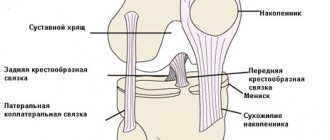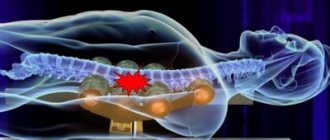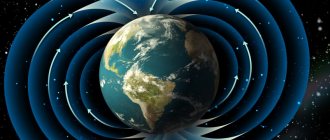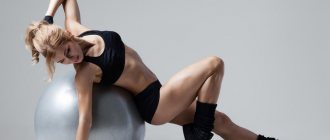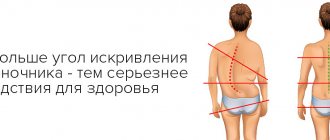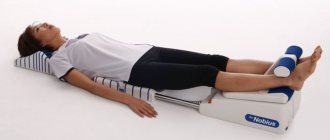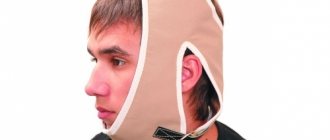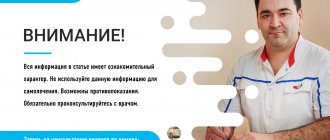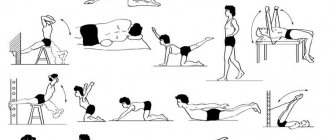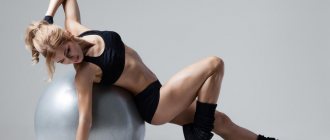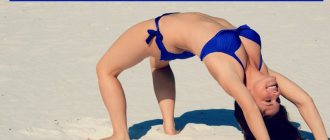Man is the only creature on earth whose main mode of movement is upright walking. The creature closest to humans, in similar conditions, is the giraffe with its long neck. But in humans, unlike a giraffe, all parts of the spine are located vertically, and are subject to the greatest influence of gravity.
This is a lumbar hernia on an MRI.
To combat the force of gravity, nature has come up with many compensatory mechanisms. These are the physiological curves of the spine, lordosis and kyphosis, which make the contours of the spinal column in the sagittal plane somewhat similar to the integral sign. This is an elastic and springy arch of the foot, and finally, this is the presence of intervertebral discs, which play the role of softening pads that prevent shaking the skull and brain when walking and running.
Throughout life, a person is exposed to the destructive influence of gravity, and the most convincing evidence of its effect can be considered the increase in the height of astronauts who spent several months in orbit. This increase was caused by an increase in the thickness of the intervertebral discs, deprived of the action of gravity. But what can we say about astronauts, because young people’s height in the morning is always 1-2 cm higher than in the evening before bed. The reason is the same.
Therefore, it is natural that in the treatment of many diseases of the musculoskeletal system, traction is used as a complex of force effects, the reverse of earth’s gravity. Spinal traction is used for protrusions and hernias, especially in the lumbar region, which is loaded most heavily. It is known that it is high and uneven pressure on the disc that is the producing factor, as a result of which protrusion, or bulging of the disc, first occurs. Then its outer layers rupture, and the protrusion turns into a hernia.
Among the types of mechanotherapy, there are various methods of spinal traction, which are otherwise called traction therapy. What is traction therapy? To what extent is spinal traction indicated for intervertebral protrusions and hernias?
Content
- Cervical spine traction: features of the method
- Stretching the neck muscles: in what cases is it used?
- Expert opinion
- Traction of neck muscles using the Ormed device
The importance of the cervical spine for human health cannot be overestimated: this is where the main blood vessels, respiratory and digestive tracts, etc. are concentrated. Therefore, pain that arises in this department causes extraordinary discomfort and must be treated immediately, and the most accessible method for this is neck traction.
Medical professionals successfully use various methods of stretching the muscles of the neck and back, so our patients can be confident that we will be able to select the optimal treatment method that is suitable specifically for their case.
You can verify the effectiveness of treatment for neck pain in our center with the help of photos, videos about our method, as well as numerous positive reviews from our patients.
During traction, the traction load does not exceed 4-7 kg, this helps to increase the distance between the cervical vertebrae, release the pinched nerve root, and improve blood supply to the brain.
Warm-up gymnastics
An effective set of exercises for the neck begins with warm-up exercises, which serve to relax and stretch the muscles of the cervical spine. If you start exercising without warming up, you risk damaging your muscles. If you feel uncomfortable when turning your head, warming up exercises are all the more necessary.
Flexion-extension
Sit comfortably on a chair and begin to gradually tilt your head down. When you touch your chest with your chin, begin to slowly tilt your head back.
Strengthen the effectiveness of gymnastics. Rest your chin on the backs of your hands. Smoothly tilt your head, but at the same time you should experience resistance from your hands.
Move your hands back, clasping the back of your head, and begin to slowly tilt your head back. Gradually increase your resistance.
Side bends
Sit straight on a comfortable chair and begin to smoothly tilt your head to the right. Do this until the tip of your ear touches your shoulder. If you feel uncomfortable, stop bending at this stage. Then start side bending to the left.
When performing the exercise, never raise your shoulders! You must achieve an inclination that is comfortable for you, then repeat the elements. Holding your hands near your ears, tilt your head with optimal resistance, gradually increasing it.
Turns
Having sat comfortably, slowly turn your head until it stops, and then begin a smooth turn in the opposite direction. In order to increase the load on the neck muscles, also help yourself with your hands.
Press the back of your right hand to your right cheekbone, and your left hand to your left cheekbone. When turning your head, overcome the resistance of one or the other limb.
Always start your exercises with warm-up exercises.
Cervical spine traction: features of the method
Traction of the neck, as well as the spine, can occur in different ways. For example, this can be done either manually or using a machine. There are also known methods for stretching the neck using various loops, simple and inexpensive devices that can be easily used even at home. All these methods involve applying a directed load to the cervical spine, which helps reduce pain, return discs and vertebrae to their “places,” relieve spasms, and relax muscles. The choice of a specific method depends on the type of disease and the patient’s condition.
For any disease, it is very important not to overdo it with the load, because in this way you can only aggravate the situation and provoke complications. Therefore, before starting treatment, you must consult your doctor and get his recommendations. In our center you can sign up for a consultation with a specialist on any issues related to neck and spine problems.
Sign up for treatment
Types of stretching or traction
There are three types of pulling: manual, underwater, and hardware. Underwater traction can also be hardware-based, but still modern equipment has electronic control units, electric motors, hydraulic drives, and cannot do without electricity. It is not economically profitable to make completely waterproof parts of devices for underwater traction. Therefore, manual and hardware traction are “dry” methods of traction therapy, and underwater traction is a combined method that combines mechanotherapy itself and balneological effects.
Manual traction
Typically, manual traction is never advertised separately on the websites of private medical centers: it is included in the appointment of a doctor - a chiropractor, an orthorelaxation specialist, a kinesiotherapist, and similar specialists. By the way, the simplest manual traction that you can do yourself is hanging on a horizontal bar.
There can be manual traction of all parts of the spine, and for patients who are indicated for this type of mechanical action, it is best to start with manual methods. The fact is that manual traction is carried out more gently, with little load, and in a more gentle way than hardware traction. This allows the doctor to better dose the effort; he feels the immediate reaction of the spasmed muscles and ligaments under his hands, and during traction he makes the appropriate correction. With hardware traction this is not possible. A doctor, especially an experienced vertebrologist, always feels what pressure is needed, what the direction of the thrust vector is, he receives feedback from the patient, which is not only verbal, but also felt under the fingers.
Underwater traction
Underwater traction is the most effective method of traction therapy. In contrast to “dry” methods, the patient’s preliminary stay in the bath allows one to achieve very good muscle relaxation and joint response. The simultaneous effect of warm, relaxing water and a mechanical traction vector is the most complete method of treatment.
Procedures in the pool.
The balneological component can be represented by either ordinary fresh water or mineral water. The patient may be in a carbon dioxide-hydrogen sulfide bath, radon, sodium chloride, or even turpentine. The chemical composition of water allows procedures to be carried out in different ways, as well as the existing gradation of temperature effect.
Thus, a hydrogen sulfide and turpentine bath dilates blood vessels, improves peripheral blood flow, and allows for pronounced muscle relaxation, therefore this traction is indicated for patients with radiculitis against the background of vegetative-trophic disorders. If the patient takes sodium chloride baths, this especially improves the function of venous outflow, and they will help patients with chronic venous insufficiency in the pelvic area, lower extremities, with various edema and varicose veins. Finally, the use of radon baths can quickly relieve pain in patients with uncomplicated protrusions and hernias.
It is precisely in patients with protrusions and hernias of the lumbar spine that underwater traction is indicated. If the patient is in the water with his legs extended, the lumbar lordosis decreases slightly, and stretching under water often immediately stops the radicular pain syndrome.
Being in the water practically reduces the weight of the human body to zero, and this allows underwater traction in a wide variety of positions. This is a vertical (Hungarian) pose, a horizontal position, sagging the body, partially pulling it out of the water instead of weights, that is, treatment with one’s own weight, and so on.
Perhaps the only drawback of underwater traction is the need for a modern balneological department. Quite often, one bathroom is not enough, and at least a swimming pool is needed. The ideal location for underwater traction devices is at a sanatorium with a constant source of healing mineral waters, with the possibility of heating them.
Hardware traction
Finally, hardware traction can be considered the most accurate method, which dispenses the load literally by millimeter. Currently, many domestic and foreign companies produce modern traction tables, which, in addition to dosed traction with weights, provide the possibility of multi-level acupressure, the impact of special massage rollers, and so on. Modern traction tables make it possible to alternately and repeatedly influence the ligamentous apparatus of the deep back muscles with repeated flexion and extension, dosed compression and stretching.
Among modern traction tables, the following models should be noted: traction table Hill Anatomotor Lux, Eltrac 471 (Netherlands), domestic table “Ormed-Professional”. Naturally, the vast majority of private medical companies located in large cities provide traction services using modern devices.
Stretching the neck muscles: in what cases is it used?
The traction process itself is quite universal and is used for different indications. Cervical spine traction may be necessary:
- for various curvatures (scoliosis);
- for various curvatures (scoliosis);
- with torticollis;
Traction of the neck during a hernia at its different stages helps to return the vertebrae to their places and reduce (and even completely disappear) the hernia itself. In the event that destruction processes have already begun in the vertebrae and tissues, stretching is carried out under the supervision of a specialist. The same can be said about traction of the cervical spine during protrusion. Therefore, it is very important not to self-medicate, but first of all to consult a specialist. Only a competent doctor can understand the overall picture of the disease and prescribe the correct course of treatment.
Indications and contraindications
It is extremely important to know which patients can undergo traction and which cannot, and perhaps we should start with contraindications. There are general contraindications for which no physiotherapeutic procedures can be performed at all, and they need to be known very clearly. This:
- any malignant neoplasms;
- tuberculous lesions of the vertebrae, or tuberculous spondylitis;
- hemorrhagic syndrome and low blood clotting with a tendency to bleed;
- fever, and acute infections
- decompensated cardiopulmonary, hepatic and renal failure;
- infectious and inflammatory skin lesions (pyoderma, streptoderma, erysipelas);
- coronary heart disease, rest angina;
- hypertensive crisis, high blood pressure, high-grade hypertension;
- various heart rhythm disturbances;
- chronic cerebrovascular insufficiency, recent stroke;
- acute disorders of spinal circulation (spinal cord stroke);
- pregnancy;
- some mental illnesses during exacerbation (schizophrenia, bipolar disorder, epilepsy).
Now we will list those contraindications for which some physiotherapeutic procedures can be performed, for example, the use of electric current, galvanization, electrophoresis, laser treatment, but traction is prohibited. This is a pathology such as:
- spinal canal stenosis;
- high degree of vertebral instability;
- scar-inflammatory changes in the membranes of the spinal cord;
- degenerative bone lesions in the form of severe osteoporosis;
- presence of multiple myeloma;
- pathology of the parathyroid glands;
- scoliosis with pronounced asymmetry;
- wounds, trophic ulcers in places where traction cuffs are applied;
- various deformations of the limbs in the form of curvatures, in which traction along the length of the bone is impossible;
- the presence of effusion or exudative-inflammatory changes in the joint cavity.
Finally, traction is contraindicated in childhood and in the elderly. The use of traction in very massive people can also be considered a general contraindication, and there are various types of restrictions here. Imported tables allow patients weighing about 120 kg to sit on them, but in general, 100-110 kg is considered the limit. In the case of underwater traction, the patient’s weight does not matter much, but still, with extremely severe obesity, this type of mechanotherapy will be contraindicated.
Who is traction therapy indicated for? Patients if available:
- protrusions and hernias;
- chronic myofascial pain syndrome;
- threatening transformation of the protrusion into a hernia (fissure of the fibrous ring);
- radicular compression;
- reflex neurovascular syndrome;
- pseudospondylolisthesis, that is, a condition in which the overlying vertebra slips from the underlying one to a distance not exceeding 1/3 of the vertebral body, if we talk about the lumbar spine;
- initial manifestations of ankylosing spondylitis, or ankylosing spondylitis, if mobility in the vertebrae is preserved;
- flattening of the lumbar lordosis.
There are other indications that are determined by a neurologist, orthopedist or vertebrologist.
Traction of neck muscles using the Ormed device
Separately, it is worth considering traction using special equipment. In the medical department, spinal traction is performed using the Ormed-Professional apparatus. This device allows you to very accurately determine the load, thereby not overloading the damaged area and without causing any complications. In addition, it is possible to regulate both the load itself and its direction.
Physiotherapist-rehabilitologist Irina Viktorovna Skrypova comments:
If you experience any discomfort or pain in the neck area, we advise you to seek advice from our center. The specialists working here will accurately determine the nature of the damage and prescribe the optimal course of treatment.
Sign up for treatment with us by phone +7 495 134 03 41
or leave a request on the website.
Author of the article:
Litvinenko Andrey Sergeevich
Orthopedist
Make an appointment
Recent publications by the author:
- Myostimulation (electromyostimulation) for weight loss
- Shock wave therapy of the hand
- Where can I get an ultrasound of my hand?
- Ultrasound of the wrist
Causes
The exact etiology has not yet been found. There are risk factors that lead to the disease. These include:
- Metabolic disease.
- Poor eating habits, excess weight, hypovitaminosis.
- Tobacco intoxication.
- Pathology of the cardiovascular system.
- Hormonal disorders.
- Hereditary predisposition.
- Age.
- Injuries of the spinal column and motor system.
- Physical inactivity, sedentary lifestyle.
A combination of factors leads to degeneration of cartilage, bone tissue and the appearance of symptoms in the form of pain in the shoulder girdle, tingling and numbness of the fingers, and headaches.
Our doctors
- LITVINENKO Andrey Sergeevich
Traumatologist orthopedist Sports medicine doctor Experience: 19 yearsSign up
- SKRYPOVA Irina Viktorovna
Physiotherapist rehabilitator Experience: 20 yearsSign up
- MOISEENKO Alexey Yurievich
Traumatologist orthopedist Sports medicine doctor Experience: 17 yearsSign up
- KHOLIKOV Timur Vyacheslavovich
Traumatologist orthopedist Sports medicine doctor Experience: 19 yearsSign up
How to determine the size of a neck brace?
To determine the dimensions when choosing a Shants collar, the following measurements are required using a centimeter tape:
- neck height
– calculate the distance between the middle of the clavicle and the extreme point of the lower jaw;
- neck circumference
– measured as neck circumference.
| neck circumference (cm) | 20-32 | 20-32 | 20-32 | 20-32 | 30-35 | 35-45 | 30-35 | 35-45 | 30-35 | 35-45 | 30-35 | 35-45 |
| neck height (cm) | 4 | 5 | 6 | 7 | 8 | 8 | 9 | 9 | 10 | 10 | 11 | 12 |
The resulting dimensions should be compared with the table provided by the neck brace manufacturer. The principles for determining sizes for Shants collars are the same for both children and adults.
